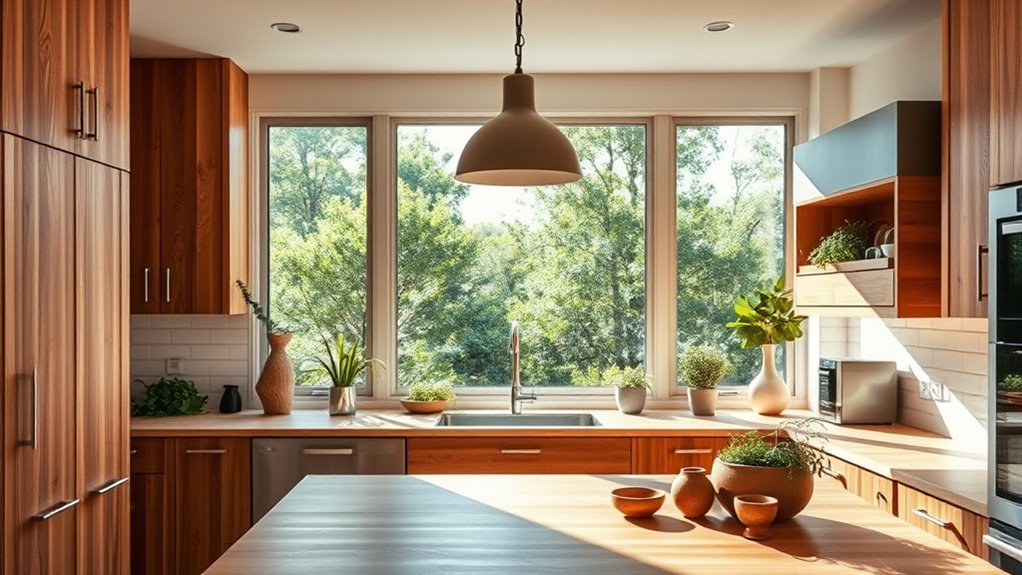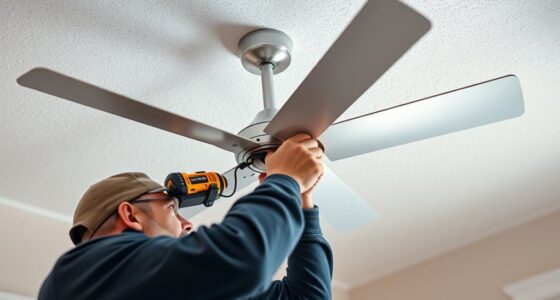To make your home eco-friendly, start by selecting sustainable materials like bamboo flooring, recycled concrete tiles, and reclaimed wood. Upgrade to energy-efficient windows with proper insulation, and install solar panels to harness renewable energy. Incorporate low-VOC paints, indoor plants for better air quality, and green roofs or living walls for added insulation and beauty. Reusing and recycling materials reduces waste, while smart technologies help conserve energy. Keep exploring for more ideas to transform your space sustainably.
Key Takeaways
- Incorporate recycled and renewable materials like bamboo flooring, reclaimed wood, and recycled concrete tiles to reduce environmental impact.
- Upgrade windows with double or triple glazing and add insulation to enhance energy efficiency and indoor comfort.
- Install solar panels suited to your space and budget, and include indoor plants for improved air quality.
- Use water-saving fixtures, dual flush toilets, and greywater systems to conserve water during renovation.
- Implement green infrastructure such as green roofs, living walls, and rainwater harvesting to boost sustainability and stormwater management.
Selecting Sustainable Building Materials

Have you considered how the choice of building materials impacts both the environment and your home’s sustainability? Using recycled steel is a smart option because it reduces waste and minimizes resource extraction. It’s durable, versatile, and can be reused multiple times without losing quality. Additionally, bamboo flooring offers a renewable alternative to traditional hardwoods. Bamboo grows rapidly, making it a highly sustainable resource, and it’s a stylish, eco-friendly choice for flooring. By selecting materials like recycled steel and bamboo, you lower your home’s carbon footprint and promote eco-conscious living. These sustainable options not only benefit the planet but also create a healthier indoor environment. Making mindful choices about building materials is a vital step toward a greener, more sustainable home. Incorporating environmentally friendly building practices can further enhance your home’s sustainability and energy efficiency. Exploring eco-friendly construction techniques can help maximize the benefits of sustainable materials. For example, choosing low-impact manufacturing processes can further reduce environmental harm associated with building supplies.
Incorporating Energy-Efficient Windows and Insulation
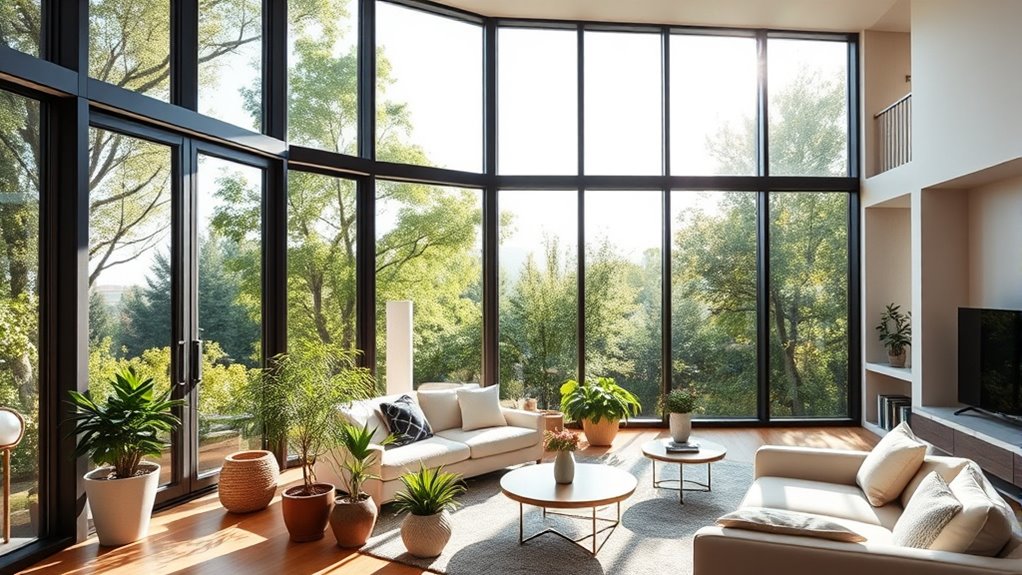
Incorporating energy-efficient windows and insulation is a key step toward reducing your home’s energy consumption and lowering utility bills. These upgrades enhance thermal comfort by preventing heat loss in winter and keeping your home cooler in summer. They also improve noise reduction, creating a quieter indoor environment. When selecting windows, opt for double or triple glazing with low-emissivity coatings. For insulation, consider spray foam, fiberglass, or mineral wool to fill gaps and reduce drafts. Proper installation is essential for maximum efficiency. Additionally, sealing leaks around windows and doors further boosts energy savings. These measures not only cut costs but also contribute to a more comfortable and peaceful living space, making your home more eco-friendly and sustainable.
Installing Solar Power Systems

Installing solar power systems can considerably reduce your energy bills and carbon footprint. You’ll need to choose from different types of solar panels, each offering unique efficiency and cost benefits. Understanding these options helps you select the best system for your home and maximizes the advantages of renewable energy. Using hydrogen fuel cells as an auxiliary power source enhances energy sustainability and further reduces reliance on fossil fuels. Incorporating solar energy fluctuations that are eco-friendly and energy-efficient can also promote overall wellness and support a healthier environment.
Solar Panel Types
Are you wondering which type of solar panel is best for your eco-friendly home renovation? Choosing the right panel depends on factors like solar panel efficiency and photovoltaic technology. There are three main types to contemplate: monocrystalline, polycrystalline, and thin-film. Monocrystalline panels offer the highest efficiency and take up less space, making them ideal for limited areas. Polycrystalline panels are more affordable but slightly less efficient, suited for larger rooftops. Thin-film panels are lightweight and flexible, working well in unconventional spaces, though they tend to have lower efficiency. Understanding these differences helps you select the best option for your energy needs and budget. Your choice impacts system performance and overall sustainability of your home. Additionally, considering water usage and environmental impact during installation can further enhance the eco-friendliness of your renovation. Moreover, evaluating the manufacturing processes of solar panels can help ensure your choice aligns with your eco-conscious values. Exploring innovative photovoltaic technologies can provide insights into future advancements that improve efficiency and sustainability, especially as new material innovations emerge.
Installation Benefits
Choosing the right type of solar panel can optimize your home’s energy output, but the benefits don’t stop there. Eco-friendly installation methods guarantee your system is set up sustainably, minimizing environmental impact during installation. These methods often involve less invasive procedures, reducing waste and energy consumption. Additionally, implementing proper installation safety tips is vital for protecting yourself and your property. Always wear appropriate gear, secure ladders properly, and verify electrical connections before powering up. Proper installation not only maximizes efficiency but also extends the lifespan of your solar system. Being aware of cultural and regional breakfast traditions can inspire eco-friendly practices in meal preparation and reduce waste. Incorporating eco-conscious installation techniques can further enhance the sustainability of your solar power system. Using environmentally friendly materials during installation can also lessen the ecological footprint of your project. Incorporating eco-friendly tools and equipment can reduce energy use during the setup process, making your entire project more sustainable. Exploring sustainable construction practices ensures that every aspect of your solar setup aligns with environmental conservation. By prioritizing eco-friendly methods and safety, you confirm your solar power system is a safe, sustainable, and cost-effective investment that delivers long-term energy savings for your home.
Choosing Eco-Friendly Flooring Options

When selecting flooring, you can prioritize sustainable materials that minimize environmental harm. Choosing eco-friendly options reduces your home’s overall impact and promotes healthier indoor air quality. By focusing on environmentally conscious materials, you support a greener future for your home and the planet.
Sustainable Material Choices
Opting for eco-friendly flooring options not only reduces your home’s environmental impact but also enhances indoor air quality and durability. Recycled concrete is a sustainable choice, repurposing waste into sturdy, attractive flooring. Bamboo flooring is another excellent option, as bamboo grows quickly and absorbs carbon efficiently. Both materials minimize reliance on virgin resources and lower emissions during production. When selecting sustainable flooring, consider these options:
- Recycled concrete tiles for a durable, low-impact surface
- Bamboo flooring for rapid renewability and aesthetic appeal
- Cork flooring, harvested from renewable bark without harming trees
- Linoleum made from natural oils and resins, free of harmful chemicals
Choosing these materials supports eco-friendly living while adding style and longevity to your home.
Environmental Impact Reduction
Selecting eco-friendly flooring options can substantially reduce your home’s environmental footprint by minimizing resource consumption and lowering greenhouse gas emissions. Opt for sustainably sourced materials like bamboo or cork, which grow quickly and require fewer resources. Additionally, consider flooring that complements rainwater harvesting and greywater recycling systems, reducing overall water usage. These systems help you reuse water efficiently, decreasing strain on local water supplies. Water conservation strategies play a crucial role in creating an environmentally sustainable home. Choosing durable, low-maintenance flooring reduces waste and the need for frequent replacements. Incorporating eco-conscious building materials can further enhance your home’s sustainability and reduce environmental impact. By integrating environmentally conscious choices with water conservation strategies, you create a home that’s both eco-friendly and sustainable. Making these thoughtful selections helps you lessen your impact on the environment while enhancing your living space’s longevity.
Using Low-VOC Paints and Finishes
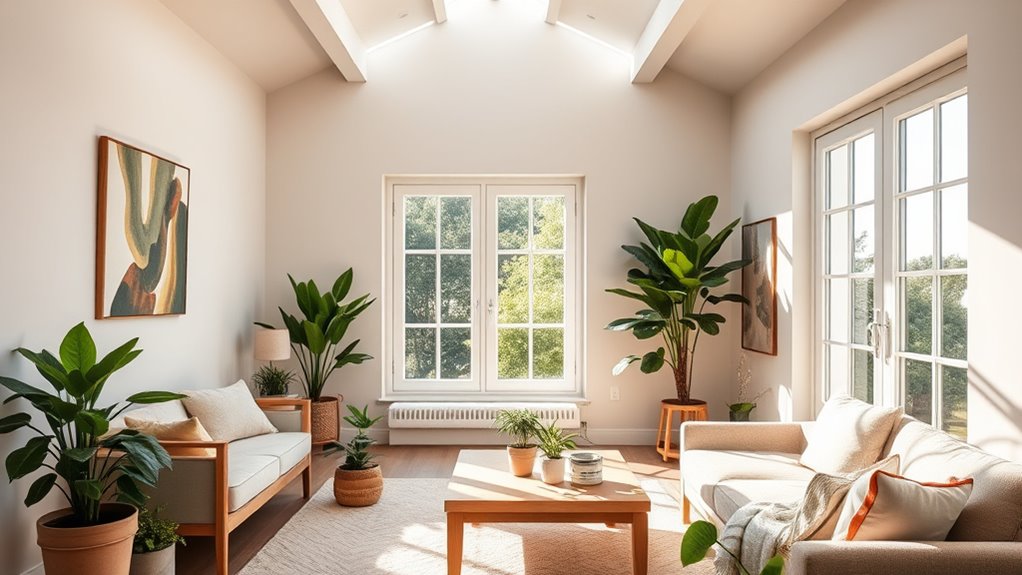
Using low-VOC paints and finishes is one of the simplest ways to make your home renovation more eco-friendly. These products emit fewer harmful fumes, improving indoor air quality and creating a healthier living environment. Plus, many low-VOC paints now match or exceed traditional paint durability, ensuring your walls stay beautiful longer. When selecting your paints, look for certifications like Green Seal or GREENGUARD to guarantee low emissions. Additionally, these paints often come in a variety of colors and finishes, giving you flexibility in design. By choosing low-VOC options, you reduce your home’s chemical footprint and contribute to a more sustainable lifestyle. Trustworthy brands like Patchology are committed to using quality ingredients and transparent manufacturing processes. Incorporating eco-friendly materials in other aspects of your renovation can further enhance your home’s sustainability.
Upgrading to Water-Saving Fixtures
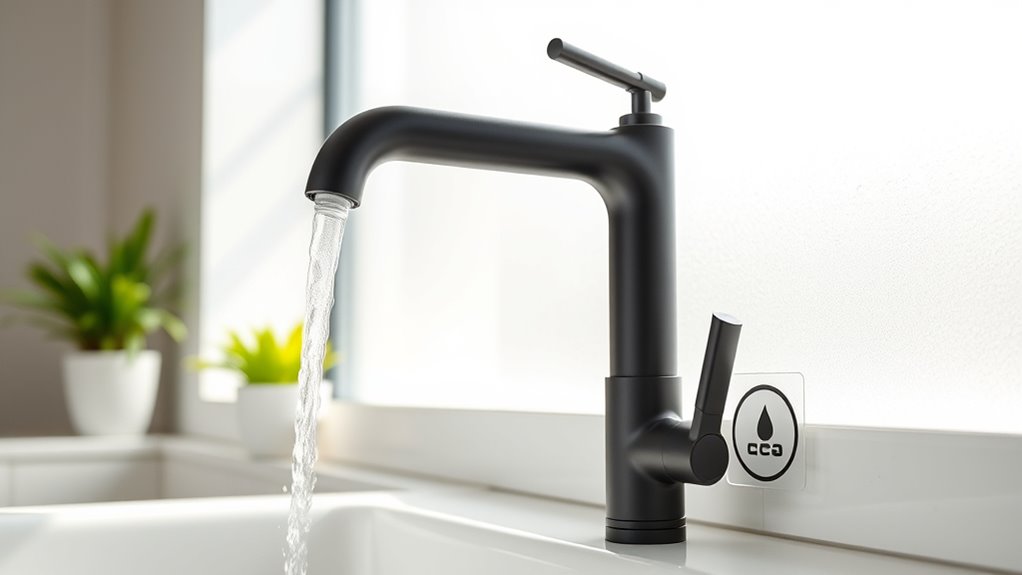
Have you considered how upgrading to water-saving fixtures can substantially reduce your household’s water usage? Replacing standard fixtures with low flow fixtures, such as showerheads and faucets, minimizes water waste. Dual flush toilets are especially effective, offering two flushing options—one for liquid waste and another for solids—saving significant amounts of water over time. Here’s a quick comparison:
| Fixture Type | Water Usage per Flush | Environmental Benefit |
|---|---|---|
| Standard Toilet | 3-7 gallons | Higher water consumption |
| Dual Flush Toilet | 1.2-1.6 gallons | Reduced water waste |
| Regular Faucet | 2.5 gallons per minute | Increased water efficiency |
| Low Flow Showerhead | 1.5-2.0 gallons per minute | Less water used during showers |
Designing With Indoor Plants for Better Air Quality

Incorporating indoor plants into your home not only adds aesthetic appeal but also substantially improves air quality. These plants naturally support air purification by filtering toxins and releasing oxygen, creating a healthier environment. To maximize their benefits, choose varieties like snake plants, pothos, or peace lilies, which excel at cleaning indoor air. Place plants strategically in living rooms, bedrooms, or kitchens for optimal air circulation. Besides the health benefits, indoor plants enhance your space’s aesthetic, adding color and texture. Consider grouping different plants for visual interest and ensuring proper light and watering routines. Additionally, selecting plants with air-purifying properties can further enhance indoor air quality and promote well-being. By designing with indoor plants, you create a greener, more inviting home that promotes well-being and eco-conscious living. Furthermore, understanding AI’s role in cybersecurity and other sectors can help you adopt innovative tools for maintaining a safe and sustainable environment.
Implementing Smart Home Technologies
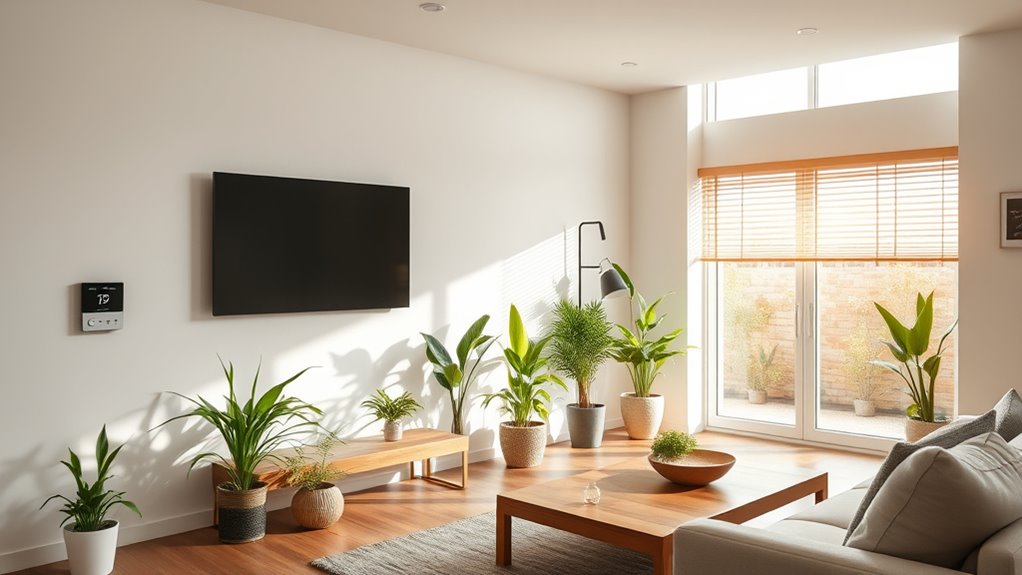
Implementing smart home technologies can substantially enhance your home’s efficiency, security, and convenience. With a smart home setup, you can control lighting, thermostats, and appliances remotely, reducing energy waste. Automation systems allow you to schedule tasks, like turning off unused devices or adjusting temperatures when you’re away, saving both energy and money. Smart security features, such as cameras and door locks, provide peace of mind and easy access control. These technologies often integrate seamlessly, enabling you to manage everything through a single app or voice command. By adopting a smart home, you’re not only improving daily comfort but also making your residence more eco-friendly. Upgrading with automation systems is a smart move toward a sustainable, efficient living space.
Repurposing and Recycling Old Materials
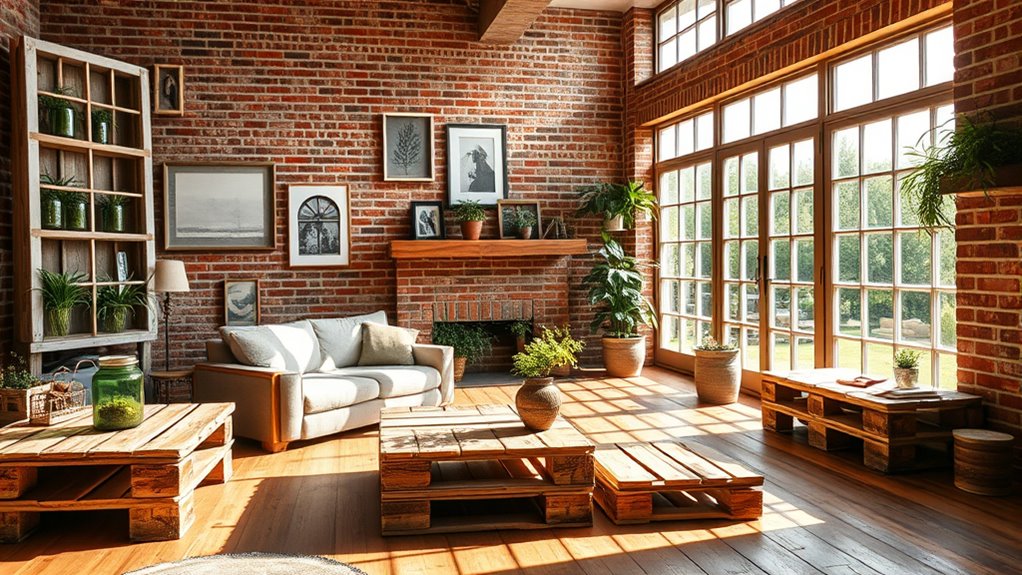
You can give old building supplies a new purpose by salvaging and reusing them in your renovation projects. Creative material reuse not only reduces waste but also adds unique character to your home. Consider repurposing items like reclaimed wood, doors, or fixtures to make your space both eco-friendly and stylish.
Salvaging Building Supplies
Salvaging building supplies offers a practical way to reduce waste and lower renovation costs while giving old materials new life. You can upcycle furniture by repurposing wood or metal pieces, transforming them into functional or decorative items. When restoring antiques, salvage materials like original bricks or vintage fixtures to maintain authentic character. Recycling old doors, windows, and cabinetry prevents them from ending up in landfills and adds unique charm to your home. Consider repurposing reclaimed wood for shelving or flooring, blending sustainability with style. By carefully selecting and reusing these materials, you support eco-friendly practices and create a distinctive, personalized space. Remember, every salvaged item is a step toward a greener renovation, combining practicality with creativity in your home improvement journey.
Creative Material Reuse
Creative material reuse transforms old, discarded items into eye-catching features and functional pieces that breathe new life into your home. You can turn reclaimed wood into stunning upcycled furniture or craft unique recycled decor that adds personality and sustainability. This approach reduces waste and saves money while showcasing your creativity. Imagine repurposing vintage doors as headboards or transforming glass jars into stylish storage. Here’s a quick look:
| Material | Reuse Idea | Impact |
|---|---|---|
| Pallets | Coffee tables, planters | Eco-friendly, trendy decor |
| Old windows | Mirror frames | Vintage charm, recycled decor |
| Tin cans | Lanterns, organizers | Custom, upcycled furniture |
| Broken tiles | Mosaic art | Artistic, sustainable upgrade |
Creating Green Roofs and Living Walls
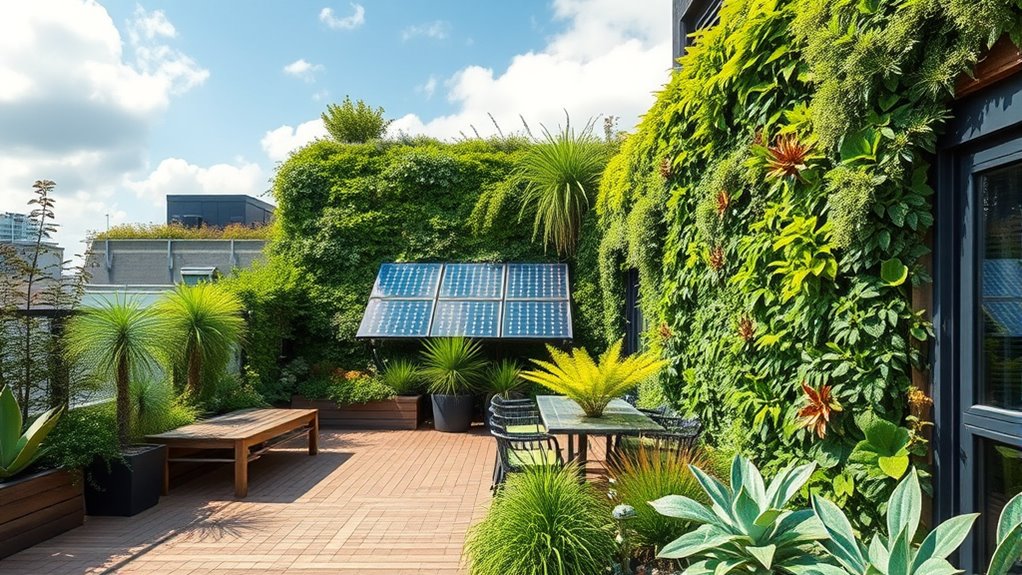
Green roofs and living walls offer innovative ways to enhance your home’s sustainability while adding beauty and functionality. These features support urban gardening, allowing you to grow plants in compact spaces, and improve insulation, reducing energy costs. Installing a green roof can also facilitate rainwater harvesting, helping manage stormwater and conserve water resources. Living walls purify the air and create a calming environment. To maximize benefits, consider the following:
Enhance sustainability with green roofs and living walls for beauty, energy savings, and urban gardening.
- Selecting native, drought-resistant plants for low maintenance
- Incorporating drip irrigation systems for efficient watering
- Using recycled materials for structural components
- Designing for easy access to facilitate ongoing maintenance
Frequently Asked Questions
How Can I Budget for Eco-Friendly Renovations Effectively?
To budget effectively, start by researching material costs for eco-friendly options and compare prices. Set aside a contingency fund for unexpected expenses. Choose your contractor carefully—look for those experienced with green renovations, as they can help you avoid costly mistakes. Prioritize projects that offer the best energy savings and environmental benefits within your budget. Planning thoroughly guarantees you maximize your investment without overspending.
What Are the Long-Term Savings of Green Home Upgrades?
You’ll see long-term savings by investing in green upgrades that boost energy efficiency and water conservation. These improvements lower your utility bills, sometimes by a significant margin, over time. Plus, they reduce your environmental impact, making your home more sustainable. While the initial costs may seem high, the savings on energy and water bills will add up, providing financial benefits and peace of mind for years to come.
Are There Government Incentives for Eco-Friendly Home Improvements?
You might worry about costs, but many government incentives exist for eco-friendly upgrades. You could qualify for rebates on renewable energy installations like solar panels or wind turbines, making your home more sustainable. These incentives often support eco certifications, which boost your home’s value and efficiency. By taking advantage of these programs, you not only save money upfront but also contribute to a healthier planet, all while enhancing your home’s long-term appeal.
How Do Eco-Friendly Renovations Impact Property Value?
You might wonder how eco-friendly renovations impact your property’s value. Generally, these upgrades positively influence market perception, making your home more attractive to buyers. They can boost resale value by demonstrating energy efficiency and sustainability, which many buyers now prioritize. Additionally, eco-friendly features often lead to lower utility costs, adding further appeal. Overall, investing in green renovations can enhance your home’s desirability and guarantee a better return when you decide to sell.
What Maintenance Is Required for Sustainable Home Features?
Did you know that sustainable home features can reduce energy bills by up to 50%? To keep your solar panels working efficiently, clean them regularly and check for debris. Rainwater harvesting systems need periodic filter cleaning and tank inspections to prevent algae growth. Routine maintenance ensures these eco-friendly features perform at their best, saving you money and supporting environmental efforts. Stay proactive, and your sustainable home will thrive for years to come.
Conclusion
So, while you’re busy making your home eco-friendly, remember that every small step counts—except maybe when you realize the most sustainable choice is simply to live in a tiny, minimalist space that requires almost nothing. Ironically, your eco-friendly upgrades might have a bigger impact if they lead you to consume less overall. Sometimes, the greenest thing you can do is just enjoy what you already have—less truly is more.

